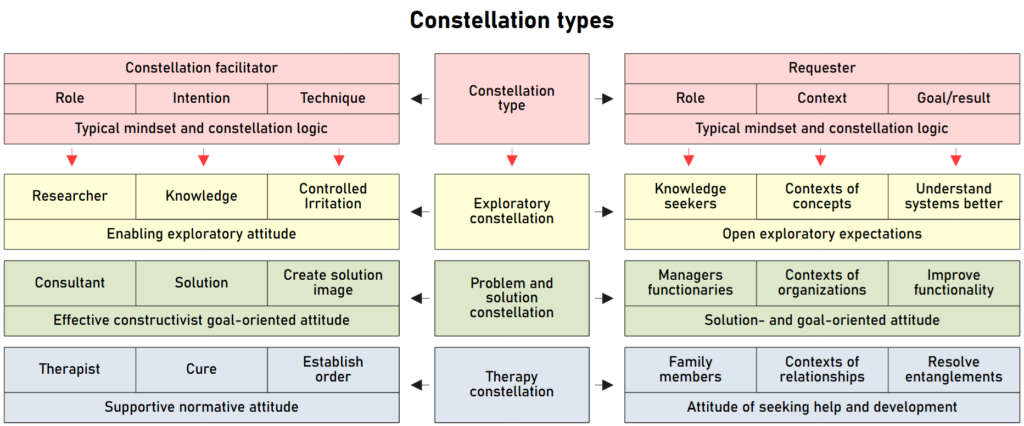What is a Systemic Exploration Constellation?
Through constellations, multifaceted complex systems can be excellently observed. This is exactly what exploration constellations are all about, in contrast to therapy, family constellations, or problem and solution constellations. In an exploration constellation, we allow the system to express itself, and we observe. We do not define a specific problem. Of course, in most cases, we want to see the areas in which we perceive problems or tensions. However, we do not allow ourselves to concretize the unwanted state to a particular cause. Often, as humans, we are not very good at doing this when we are stuck in the “problem tunnel.” In such cases, we tend to perceive reality very imprecisely. In an exploration constellation, we receive fairly clear indications of where the problems might truly lie, and sometimes this is very obvious. The key to this is the unadulterated representative perception of the representatives.

What is the Process of a Constellation?
In advance, we jointly determine which elements to set up. We assign numbers and/or letters to these elements. The elements are then represented by people who each choose a number or letter and spread out in the room. This means we work covertly, so the representatives do not know which element they represent during the constellation. This allows us to best exclude the mind and only act intuitively, leading to the true display of the relationships between the elements. During the constellation, the representatives are in representative perception.

Through their intuition, they find a fitting place in the room and express their perception towards the other elements and themselves. The facilitator systematically questions the elements and can offer appropriate interventions. After the constellation, which can last between 30 and 90 minutes, a feedback session with interpretation offers follows.
Allowing New Perspectives

In an exploration constellation, new insights emerge. However, this does not mean that everyone will immediately accept or allow these new perspectives. Often, we have very clear ideas about the world, which we consider reality and often defend against others. But if we are willing to allow the new impulses and irritations as possibilities, we can also arrive at new insights. These processes of realization initially unfold very individually in each person. The relationships that emerge in a systemic constellation stimulate these realization processes and help us develop new perceptions of the world, which expands our scope of action. And not infrequently, we develop a freer and more relaxed attitude towards our own system.
Can the Mechanism of Systemic Constellations be Explained?
So far, it is largely unclear how representative perception works in systemic constellations and how people access information they didn’t have before. Let’s draw a comparison to another example. Hans-Peter Dürr (physicist) describes a phone call on a mobile phone as follows: during the signal transmission, a dent is made into the void, which we then call an electromagnetic wave. This dent is perceived by the person on the other end as a type of form recognition. The relational structure is there, but it is not materially grounded. And it doesn’t matter where my conversation partner is. I don’t even need to know where he is. The phone simply starts ringing. As you can see, this leads to a difficulty in providing an explanation if one tries to explain these phenomena. In the case of electromagnetic waves, we now simply know that they work. No one is surprised anymore. And someone who has already participated in several systemic constellations is no longer surprised about how they work. We know they work. Through quantum physics, we now have some explanations, such as entanglement or the non-locality of information. And this allows us to roughly understand representative perception.
Für deutsche Inhalte besuchen Sie bitte Systemische Erkundungsaufstellung.
